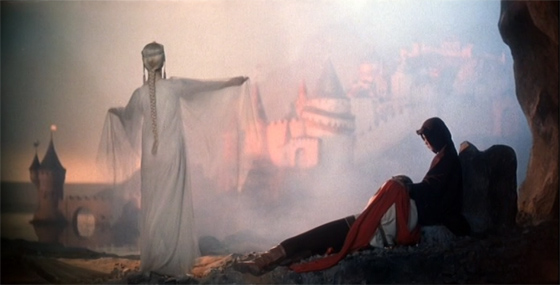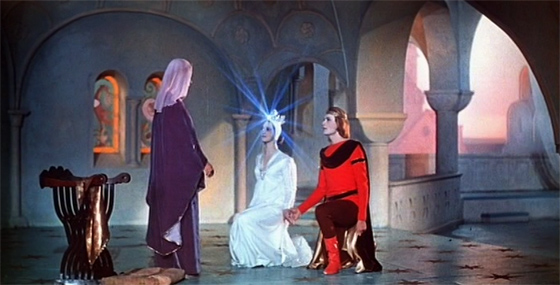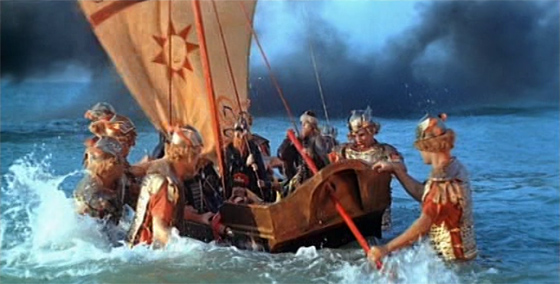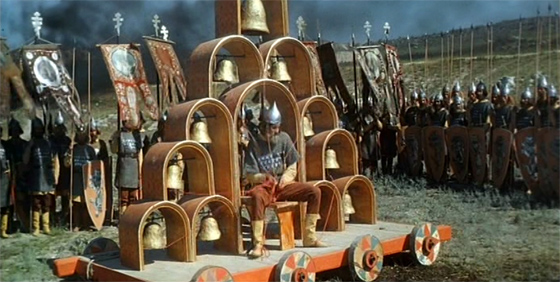
Aleksandr Ptushko’s penultimate special effects fantasy (before the sublime Ruslan and Ludmila) was The Tale of Tsar Saltan (1967), based on another of Pushkin’s poems and filled with rhyming dialogue and rich storybook imagery. The film opens with a Pushkin book being opened to an illustration of three maidens pining for the unwed tsar before Ptushko dissolves into live-action. The women are unaware that they’re being spied upon by the tsar himself (Vladimir Andreyev, distractingly buried under a bright orange beard and heavy eyeshadow), and after listening to their promises, he bursts into the room and chooses the young sister (Larisa Golubkina) who promises him a strong and brave offspring; then he spirits her away to his castle. The two jealous sisters plot the destruction of the Tsarina. While Saltan is at war with some cannibalistic trolls, he receives a forged message stating that his heir has been born, and the creature is a monster. Another forged letter in the Tsar’s name tells the boyars of the palace that they must take the Tsarina and her (perfectly healthy, albeit fast-growing) son and place them in a barrel sealed with pitch, then thrown into the sea (a scene reminiscent of Clash of the Titans). By the time the Tsar returns to the palace, he is told his wife and son are dead, and the two evil sisters are there to comfort him.

The exiled Tsarina (Larisa Golubkina) approves of the marriage of her son Guidon (Oleg Vidov) and the Swan Princess (Ksenia Ryabinkina).
Meanwhile, the Tsarina and her son, the now fully-grown Guidon (Oleg Vidov), emerge from their barrel on a secluded island. Guidon, hunting for food, slays a kite that threatens a swan. The swan transforms into a princess (Ksenia Ryabinkina) and guides mother and son to a walled castle where all its residents are frozen in time: a girl is forever pulling a goat, a fountain’s sparkling water is held stiffly in place, and men running through the street are kept impossibly still. Guidon lifts the spell and becomes prince of the city, and is shortly given a tour of its wonders, which includes golden acorns cracked by a singing squirrel-puppet. All the women wish to marry him, but are kept at bay by the Swan Princess, whose heart the prince has already won. She shows him her army of giants, who march out from underneath the sea. And she transforms the prince into a mosquito so he can visit his mourning father, Saltan, and even bite one of the evil sisters on her eye. Soon enough the Tsar is reunited with his wife and son, the sisters are forgiven their sins, and Guidon marries his Swan Princess.

Giants of the sea attack a boat fleeing the island castle.
The aesthetic of the film is that of a Maxfield Parrish painting, and the matte paintings are a wonder to behold. But it’s also chock full of the expected Ptushko tricks, gags, and surreal loopiness. He strives to remind us at every moment that this is a world of fairy tale exaggeration, and applies his animator’s expressiveness to live-action effects. In one scene, the lion statues sitting on the arms of his throne grow startled and scamper off (a brief but convincing shot with dogs in costume). When the enchanted mosquito zips through the throne room, actors leap away from it in trampoline-bounces. Action is often accelerated or played in reverse. The sea-giants are achieved through a clever mix of rear projection, optical matting, forced perspective, and miniature props – depending on the shot, a different effect is used. And then there’s that singing squirrel, reminding us of Snow White and the Seven Dwarfs, but played with an utterly goofy mechanical puppet. The playful innocence and simplicity of the film is difficult to resist: this is a lovingly crafted children’s film. If you have the Ruscico DVD, be sure to treat yourself to the animated film included with the Special Features. A gem from the legendary Soviet Soyuzmultfilm animation studio, the exquisite half-hour short from 1950 retells the Russian fairy tale “The Fisherman and the Goldfish.”










